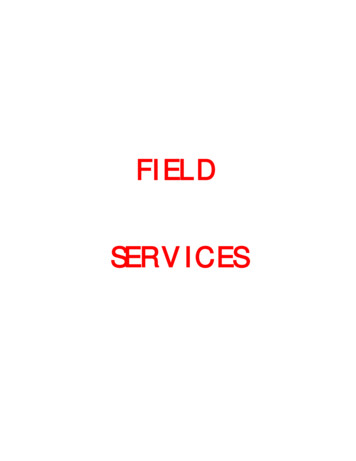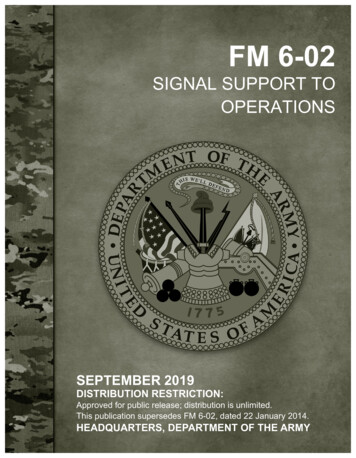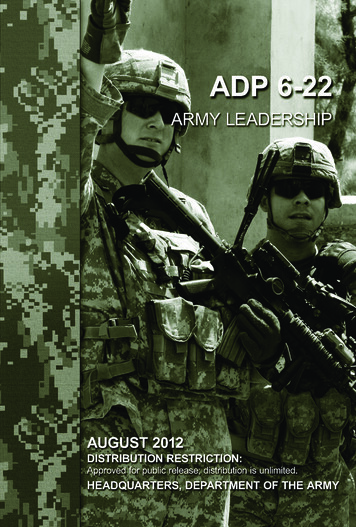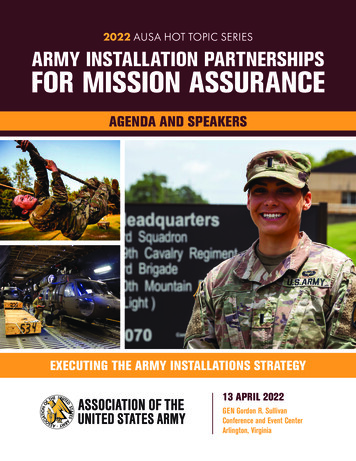
Transcription
FIELDSERVICES
In the BeginningUntil the early twentieth century the Armydid not provide laundry services to itsSoldiers.Instead this work was performed byselected women who were paid directly bythe Soldiers. Typically these were wivesof Soldiers or other respectable women, who could also do mending orother services.While the Soldiers were on the move, whether in the Civil War, thefrontier operations, or for other reasons, there was no laundry support.They just did the best they could, which wasn’t very good.
LiceLack of clean clothing resulted in theprevalence of lice in the nineteenthcentury. This very small, bloodsucking insect spreads rapidly,especially when people lived closetogether. They hide in clothing andotherwise take advantage ofunsanitary conditions.Soldiers might call them gray backs orcooties; and they considered lice to be anunpleasant but inevitable part of military life.Soldiers in barracks or in camp provided anideal environment for the spread of lice.Conditions in the trenches at Petersburg wereespecially bad.Everyone understood that lice could itch terribly, but they did notunderstand the full dangers of this pest. Lice carry disease, mostnotably typhus, a nasty and often fatal infection. Because medicalscience did not understand bacteria or how insects could spread disease,Soldiers did not realize how dangerous lice could be.In reality clean clothing wasn’t just a morale issue, it was a medicalnecessity.Just before World War I, people began to understand the dangers of lice.
Beginnings of Quartermaster Laundryand World War IThe first change in Quartermaster laundryservices came in 1909 when Congressauthorized government laundry servicesat isolated posts, mostly in the West.With little guidance post quartermastersdeveloped their own laundries, and theirown policies.As the United States entered World War I, the Army constructed trainingcamps across the United States, including Camp Lee near Petersburg. Thehuge numbers soon overwhelmed the local laundry facilities, but thegovernment was slow to react. Authorization to begin construction oflaundry plants for the training camps didnot come until August 1918, and theywere just starting to operate at the end ofthe war.These were all large buildings with heavyequipment. Quartermaster laundry onlyoperated in the United States. The Armywas not yet prepared to support Soldiersin the field.These years also marked a time of major advances in medicine, whendoctors began to learn about bacteria and how they can be spread throughinsects. Unfortunately the Army was not yet ready to transform thisknowledge into a real field laundry program.
World War I(Overseas)Soldiers from all armies during the First WorldWar lived and fought inside trenches. Thesewere ideal conditions for the spread of lice andother unsanitary conditions.The British and French had already establishedsome laundry services for their soldiers, andthe Americans attempted to follow their lead.Unfortunately these efforts were too littleand too late. The US constructed anddesigned mobile laundry plants. Theseconsisted of four large trailers, pulled by asteam tractor that also served as the powerplant. They could only travel on largeroads, and could not get close to the frontwhere they were needed most. Mobilelaundry unit did not arrive in France untilJune 1918 and the Army was justbeginning to receive regular deliveries ofthe units by the end of the war. The fewunits were used for salvage operations.By the time the fighting ended, over 90percent of the Soldiers had lice. Thesignificance of combat laundry services in1918 lay in the precedent for futureoperations, not service to the Soldiers.
SalvageWorld War I brought a newline of Quartermasteroperations known as salvagework. Basically this meantcollecting damaged clothingto be cleaned, sterilized,repaired, and returned to thesupply system. Soldiers hadthe habit of just tossing theirdamaged clothing aside, orotherwise discardingunserviceable textilematerials. Replacement with new clothing just would not haveworked. In addition to the costs, the United States lacked the shippingspace for anything but the necessary items.The American Army collected the damaged clothing, often picking itoff the ground, and then sent it to a salvage depot. Here Frenchwomen sewed the mountains of torn clothing back together before itwas returned to the supply system. By the close of the war the salvagesystem repaired and returned over 2.6 million items of clothing.The Quartermaster also operated smaller clothing repair shops forminor damage, where the uniform could be returned to the Soldier.
RedeploymentAt the end of the fighting Armyleadership realized they could not sendSoldiers home with lice. TheQuartermaster Corps was called intoaction to resolve the problem, with theaide of the Chemical Warfare Serviceand the Medical Department.Upon leaving the trenches Soldiers received weekly showers, oftenusing chemical decontamination equipment. At the same time theyreceived a change of clothing. Units received the showers and laundryservices together in order to prevent the infected Soldiers fromspreading lice. Continuous repetition of the process reduced theinfestation rate to 3 percent.Before boarding the homeward ships, the Army still wanted to removeany remaining lice infestations. At the redeployment ports ofembarkation Soldiers turned in their uniforms to be disinfected whilethey took long showers. At the same time they received a quickmedical check. Soldiers with lice had all of their hair shaved. Afterleaving the showers, they received clean underclothing. In themeantime their now sterilized uniforms were returned, but sometimesworse for the wear.
Between the WarsIt would be nice to think that the Army learned from the experienceabout supporting troops in the trenches, but this was not the case. TheArmy improved its ability to support troops in garrison, but madelittle progress at supporting troops in combat.The mobile laundry equipment was used for garrison laundries.Likewise, equipment to support the World War I training campsremained in use between the wars.From now on the Quartermaster Corps was expected to providelaundry services.Unfortunately the problem of how to support Soldiers in combatconditions received little attention. Even though the technology fortrucks was improving at this time, the Army made no effort to designnew equipment that could be placed on trucks to follow the frontlines.
Beginnings of World War IIIn June 1940 the German Army defeated the French, and GreatBritain was in serious trouble.The United States began to mobilize in case we should enter the war.This included expanding the Army by drafting Soldiers and a massivebuilding project to house the Soldiers.Once again the Quartermaster Corpsplaced its laundry emphasis uponsupporting the Soldiers at thetraining camps. New or expandedinstallations included large laundryplants, and where necessary theArmy contracted with civilian cleaners.The Quartermaster Corps now began to consider how to supportfighting soldiers in the field. At last they began designing truckmounted laundry units and the other necessities for field operations.Looking back we can say their efforts were not enough, but at leastthis was a start.
Field Services in World War IIDuring World War II, the Armydefined field services to includemany different functions, includingfield bakeries or typewriter repair.For our purposes we are interestedin laundry, bath, salvage, clothingrepair, and de-lousing.Surprisingly lice infestation was far lessduring World War II. The frequentmovements and greater dispersions of theSoldiers provided fewer opportunities forthe lice to spread.The Army did need to control lice amongthe POW’s, the liberated personnel, and civilian populations. Thistime they used a new pesticide called DDT. It seemed like a good ideaat the time; but they did not understand the long term dangers of thischemical.
LaundryEven though planning for laundry operations had a slow start at thebeginning of the war, the Soldiers did an impressive job of providingservices under difficultconditions. They operated asclose to the front lines aspossible, and made a majorcontribution to the health andwelfare of the Soldiers.The first priority for laundryservices went to medical units.Even today medical units willbe a huge customer for laundryservices. Second priority wentto salvage units. Third priority went to supporting the troops.Even with the best efforts of the laundry units, Soldiers often lackedclean clothing. The Army simply did not provide sufficient laundryunits to meet the demand.These mobile laundries were mounted on heavy trucks. They werevisible from the air, and thus vulnerable to air attack. The large sizelimited where they could go. In a fast-moving front they could notkeep pace with the troops.Consequently, the Soldiers frequently found alternative means to cleantheir clothing. Where possible they made arrangements with locallaundries (usually French) to clean their clothing. Or else they justcleaned their own clothing with whatever soap and water they couldfind.
FumigationWoolen clothing could not be washed in hot water, but it still requireddisinfection. The Army used fumigation procedures to remove lice orany other pest.Clothing was placed in chambers and a methyl bromide gas wasreleased into the chambers. It served as a powerful poison to kill anypest within the clothing.
Methods for LaundryOften the Army used bundles. to process laundry.Each Soldier was allowed a limited number ofclothing in one bundle (usually 20 items). Uponreceiving the laundry QM personnel usednumbered safety pins to identify the clothing.These pins were similar to the ones shown here.After washingthe laundry was sorted by ownerusing the pins. This was a labor intensive process.The alternative method was simply clothing exchange. A soldier turned inhis dirty laundry and received a different set of previously used clothing(including underwear) that was cleaned and sterilized. The Army usedthree sizes, small, medium, and large.Clothing exchange might not sound so appealing to us, but it had distinctadvantages for a combat situation. ASoldier did not need to worry about extraclothing, just what was on his back.The process for sorting and returningclothing was labor intensive, and timeconsuming. By the time a laundry unitcould complete the process, the customerunit might have moved on.Typically the clothing exchange was used for the front line troops, often inconnection with showers. Rear area units were more likely to use bundlesor the services of local cleaners.
Clothing RepairThe Quartermaster Corps also collectedand repaired damaged clothing, shoes,or other troop items.They used either Soldiers or local laborto do the work.During World War II every piece of clothing was important, and theseoperations saved resources.
ShowersIn theory the Engineers constructed shower points and theQuartermaster operated them. In practice there were not enoughengineers to go around.Soldiers constructed showers using expedients, or else the Armymight find local industrial facilities that had suitable showers.
How the system worked(In theory)Ideally shower, clothing exchange, and repairwere combined into a single operation tosupport the front line Soldiers.About once every week to ten days, Soldierswould go to the rear for their shower. Upon entering the shower areathey turned in their dirty clothing. After showering they received newcloths. They had their choice for size: small, medium, or large.The old clothing would be washed, steam sterilized, and inspected.Torn clothing went to salvage facilities for repair before reissue to thetroops.For the infantry Soldiers, this was a welcome opportunity to be clean, ifonly for a short time.
Trench FootBy late autumn and winter 1944, the problem oftrench foot devastated the American Army inNorthern Europe.Trench foot is a crippling foot condition causedby prolonged exposure to cold wet conditions.Feet that are cold and wet for a long time losethe blood circulation. That can be painfulenough in itself, but it also leaves the footvulnerable to other damage. Dead tissuebecomes vulnerable to fungal infections.Results can vary from extreme pain to loss of toes.American Soldiers in Northern Europe were just not prepared for thecold wet climate that autumn. Consequently they did not make theeffort to keep their feet dry. Trench foot hit with a sudden fury.The best defense against trench foot is a pair of dry socks at least daily.Consequently the QM laundry unitsbegan to process sock exchanges. Unitscollected the wet socks and receiveddry socks in return.With major command emphasis uponsock exchange and dry feet, theoutbreak subsided.
Pacific TheaterLaundry and field serviceswas difficult enough inEurope, but incredibly moredifficult in the Pacific. Herethe armies fought in jungleislands, with a tropicalclimate that was hard onSoldiers and their uniforms.In Europe the Army could often find local civilian resources to helpwhen the workload overwhelmed the laundryunits. There were no local facilities in thePacific, just the jungle. Even finding cleanwater could be a challenge.Unlike Europe, supporting units in thePacific could not just move down the road asthe lines moved forward. They shut down,prepared to board ships,traveled to the next island,unloaded, and then resumedoperations.Laundry units might beclosed for weeks.
Private George WatsonGeorge Watson entered theArmy in September 1942 andjoined the 29th QuartermasterRegiment after completinghis initial training.On 8 March 1943 his shipencountered Japanesebombers. near New GuineaAfter taking several hits theship sank and the passengersand crew abandoned the ship.Like many of his fellow passengers Watson was left in the water; but hewas a good swimmer and capable of reaching the life rafts. Instead hechose to find his drowning comrades and pull them to the life rafts. Hecontinued to save fellow Soldiers until he was overcome by exhaustionand drowned when the ship pulled him under the water.Watson’s courage that day met the standards for the Medal of Honor; butat that time the Army would not award the Medal of Honor to AfricanAmerican Soldiers. Instead he received the Distinguished Service Crossposthumously.In 1997 the Department of Defense reviewed awards given to AfricanAmerican Soldiers to determine which ones were denied the Medal ofHonor due to their race. At this time Watson was awarded the Medal ofHonor by President Clinton. Today the medal is on display in theQuartermaster Museum.
Korean ConflictField services during the Korean Conflict reliedupon the techniques developed during World WarII. This was a smaller war, and the field servicesunits were not so overwhelmed as in World WarII.Soldiers on the front lines could expect to go to aregimental shower and clothing exchange point about once a week.Once again sock exchange became a high priority for preventingtrench foot.As usual, medical units became the big customer for clean laundry.In the rear areas, the bundle system remained in place, with all thelabor of sorting the bundles.
VietnamThe Army entered the Vietnam Conflict without sufficient laundryequipment to support the rapidly growing numbers of Soldiers. Muchof the equipment was aging and in poor condition.New and better equipment began to arrive in the time following theAmerican entry into the war.Even with more equipment, the Army field laundry units could processabout 45 percent of the requirements. The remainder of the work wasperformed under local contracts.Soldiers in the front often relied upon clothing exchange
Since VietnamDuring the years following the Vietnam Conflict, the Army relied upona combination of military units and contracted support.Military units provide an indispensable ability to deploy quickly and tobe available when local support or American contractors simply werenot available.For the remainder of the 20th Century, a unit known as the CorpsSupport Command (COSCOM) kept a small laundry and bathcapability to support the maneuver units.
Desert Shield/Desert StormIn 1990 Iraq unexpectedly invaded its neighbor Kuwait. In responsethe United States deployed over 500,000 Soldiers, first to defend SaudiArabia, and then to liberate Kuwait. Other nations joined the coalition.In the rush to place combat forces into Saudi Arabia, the Americancommanders limited the numbers of logisticians, including field serviceunits. As a result the Army turned to Saudi Arabia for support.Soldiers used expedient methods to stay clean until the logisticalsystem could fall into place for supporting the Soldiers.
Other OperationsIn 1993 large numbers of Haitiansattempted to enter the United States bycrossing in small boats. In response theUnited States Coast Guard intercepted themand moved them to a holding area at the USNavy facility in Guantanamo Bay, Cuba.Guantanamo Bay was still operated by theUS Navy under an existing lease withCuba, despite the otherwise difficult relations. There were no localfacilities to support this sudden influx of people. Yet in a situation likethis they required sanitary services to prevent spread of disease.The 289th General Supply Company sent a laundry platoon toGuantanamo to service both the Haitians and the US military. Theirmilitary status made them readily available and they quicklyestablished operations that maintained sanitation in these closeconditions.When American forces conductedpeacekeeping operations in Somaliabeginning in the fall of 1993, the 16thField Services Company deployed itslaundry and bath units to support theoperation. Despite the unit’s speed inmoving, actual service to the troops wasdelayed because the cotainers with thenecessary supplies (soap, marking pins,etc.) were placed on slow moving ships.Once the supplies and equipment did arrive, the unit processed about250 bundles per day.
Recent YearsAs American Soldiers have deployed to Iraq, Afghanistan, and otherareas in operations they still require clean clothing. During a singleday of Operation Iraqi Freedom, the Army required 790,000 pieces ofclean laundry.For the most part this has been managed by contractors. Neverthelessthe need for trained Soldiers remains.
Laundry Advanced SystemAt the beginning of the 21st Century theArmy laundry systems still used too muchwater,generatedwastewater,created the smell of diesel fumes inthe clothing, and required a lot oflabor to sort the bundles. In responsethe Army introduced the new LaundryAdvanced System.The new equipment uses automated systems to detect problems andto monitor the functions. It recycles the water, using a distillationprocess. This feature allows it to operate in areas with a limitedsupply of clean water, and it is better for the environment. A steamdrying system eliminates the diesel fumes in the clothing.Clothing is bundled together in ameshed bag. The old process ofsorting by pins is no longerrequired.
Regardless of how the service is performed, the need forclean clothing and the opportunity for showers and othermeans of personnel cleanliness will remain with the Army.It is not just a matter of personal comfort, but also amedical necessity.
Field Services in World War II During World War II, the Army defined field services to include many different functions, including field bakeries or typewriter repair. For our purposes we are interested in laundry, bath, salvage, clothing repair, and de-lousing. Surprisingly lice infestation was far less during World War II. The frequent











